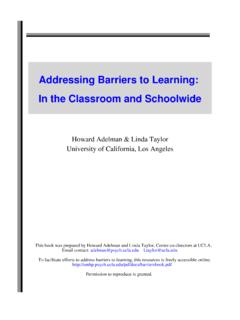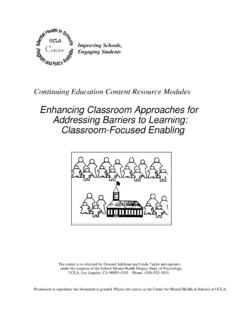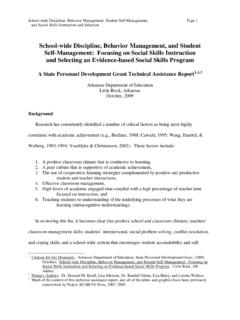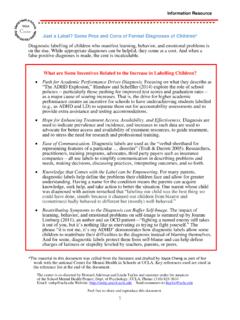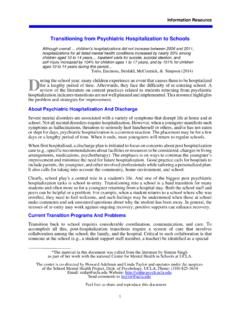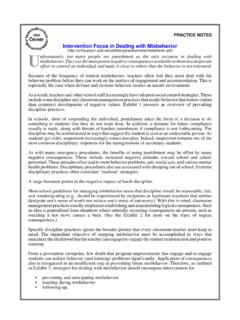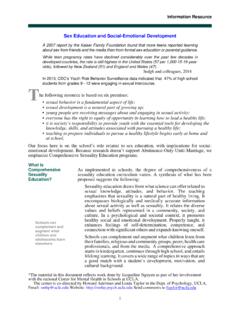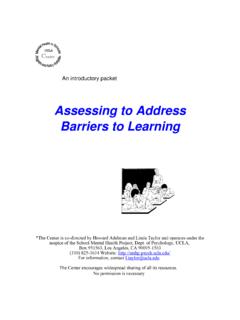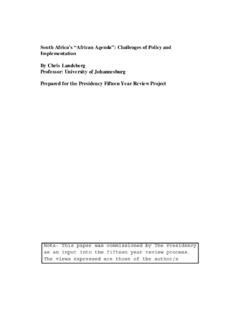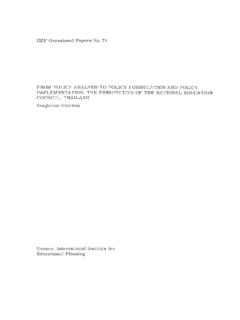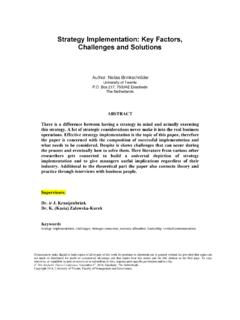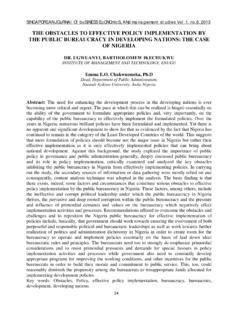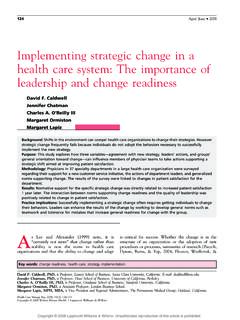Transcription of Barriers to Prevention in Schools: Prevention Policy ...
1 1 Information Resource Barriers to Prevention in Schools: Prevention Policy Implementation Barriers This resource highlights the challenges faced in implementing Prevention Policy in school settings. Key questions explored are: How does a focus on Prevention play out in schools currently? What are the Barriers to implementing Prevention Policy in schools? What s being done to address such Barriers ? What s being recommended to do it better? *This series has been initiated and uses information culled from the literature by Stephanie Moore as part of her work with the national Center for Mental Health in Schools at UCLA. The center is co-directed by Howard Adelman and Linda Taylor and operates under the auspices of the School Mental Health Project, Dept.
2 Of Psychology, UCLA, Phone: (310) 825-3634 Email: Website: Feel free to share and reproduce this document; no permission is needed. If you have comments, suggestions, examples you would like to share, please let us know. Send comments to Introduction to the series: Barriers to Prevention in Schools Prevention of learning, behavior, and emotional problems is a long-standing concern. Despite the many compelling arguments for Prevention and for minimizing the impact of factors interfering with learning and teaching, Policy makers in schools and agencies have yet to make Prevention a high priority. The purpose of this series is to underscore the reasons for this state of affairs in order to clarify ways to address Policy , practice, and implementation Barriers .
3 2 Barriers to Prevention in Schools: Prevention Policy Implementation Barriers It must be made clear and compelling to all constituencies that without effective implementation and evaluation, the potential benefits of [a] Policy will remain unrealized (Agron, Berends, Ellis, & Gonzalez, 2010, p. 535). iscussions and research regarding Prevention implementation tend to emphasize individual or small scale Prevention programs focused mainly on reducing specific risk-taking behaviors. Moreover, those programs in place in schools are so fragmented that they often produce inappropriate redundancy, counterproductive competition, and work against the type of systemic collaboration that is essential for establishing interprogram connections on a daily basis and over time.
4 All this increases costs, reduces effectiveness, and is perpetuating widespread marginalization of Prevention Policy and initiatives. Because of the marginalization, Prevention in schools usually is described as peripheral to other school activities (Durlak, 1995) and regularly is overshadowed by efforts to improve academic outcomes (Aber, Brown, Jones, Berg, & Torrente, 2011; Adelman & Taylor, 2000; 2010). How does a focus on Prevention play out in schools currently? Prevention policies creep into schools as part of direct and indirect agenda to address specific problems. Examples are: District and school staffing policies that directly call for providing and/or coordinating Prevention efforts.
5 Such efforts usually are associated with the work of student support personnel and often are discussed in relation to mental health and social services (Brener, Weist, Adelman, Taylor, & Vernon-Smiley, 2007). Schools, districts, and states policies that emphasize Social-Emotional Learning (SEL) through curricular approaches and as a facet of interventions to address problems (Aber et al., 2011; Dusenbury, Zadrazil, Mart, & Weissberg, 2011; Zeng, Boe, Bulotsky-Shearer, Garrett, Slaughter-Defoe, Brown, & Lopez, 2013). Federal Policy for Response to Intervention (RtI) directly promotes secondary Prevention (intervening as early as feasible after problem onset). Federal Policy for Positive Behavior Interventions and Support (PBIS) promotes primary, secondary, and tertiary Prevention .
6 Federal and state policies focused on safe and supportive schools stress use of evidence-based Prevention practices (Bumbarger, Perkins, & Greenberg, 2010; Hallfors, Pankratz, & Hartman, 2007). (See Sidebar on next page.) D3 What are the Barriers to Prevention Policy Implementation? What are the Barriers to implementing Prevention Policy in schools? Although research has shown an increase in Prevention related policies at state and district levels, similar improvements have not been seen at schools (Brener et al., 2007; Ingebrigtsen, 2010). A survey of school stakeholders including superintendents, state and local school board members, school wellness advocates, and state public health nutrition directors, yielded the following list of factors viewed as Barriers to implementing Prevention at schools (Agron et al.)
7 , 2010): Inadequate funding. Funding, of course, is always cited as a barrier. Concerns raised include inadequate budgets to cover costs related to personnel, capacity building, and inadequately funded mandates. Competing priorities and lack of time. Members of surveyed groups commented that lack of time arises from competing priorities and mandates stemming from contract restrictions, required curriculum, or an emphasis on academic achievement. Need to educate and gain support of key nonstaff ( , students, parents, and community members). Adequate tools to support Policy implementation and development. Competence for Providing Stakeholder Training and Technical Assistance.
8 Ambiguity in writing of laws and policies also has been identified as hindering implementation. While legislation may appear clear to those who enact it, translation into the school domain can be ambiguous to school implementers (Weaver et al., 2013). Safe and Supportive Schools Policy : A Prototypical Example Federal and state policies focused on safe and supportive schools in general and bullying in particular provide prototypical examples of efforts that bring discussion of Prevention to schools. As the Center for Mental Health in Schools (2009) has stressed: State legislatures increasingly have addressed bullying at school (including cyberbullying). The acts, however, generally do not allocate funds to enable schools to significantly confront the problem.
9 Nevertheless, the renewed legislative attention has led state and local education agencies to enhance their focus on bullying. Some state education agencies have mainly implemented the letter of the law; others have used the legislation to expand attention to the problem. Presently, almost every state has bullying legislation ( Department of Education, 2011; Weaver, Brown, Weddle, & Aalsma, 2013). Many states are requiring schools to implement bullying Prevention programs, with some mandating that the program must be evidence based (Bumbarger et al., 2010; Hallfors et al., 2007; National Center for Mental Health Promotion and Youth Violence Prevention , 2011; Weaver et al., 2013). 4 Clearly any of the above can interfere with effectively implementing and sustaining current Prevention policies.
10 However, as stressed in the next section, the most fundamental barrier to Prevention is the low priority Policy makers assign such work. And, the low priority generates an ongoing vicious cycle of piecemeal and ad hoc implementation, poor sustainability, and unsatisfactory practice, research, and training (see sidebar). An Example: Barriers to implementing Bullying Prevention Policy Bullying Prevention efforts offer an illustration of Policy -related factors that have worked against potent implementation of school programs. Most states have enacted legislation to counter bullying. While several federal agencies are involved, states still see it as their responsibility to ensure that legislation fits the specific local needs and sensibilities.
